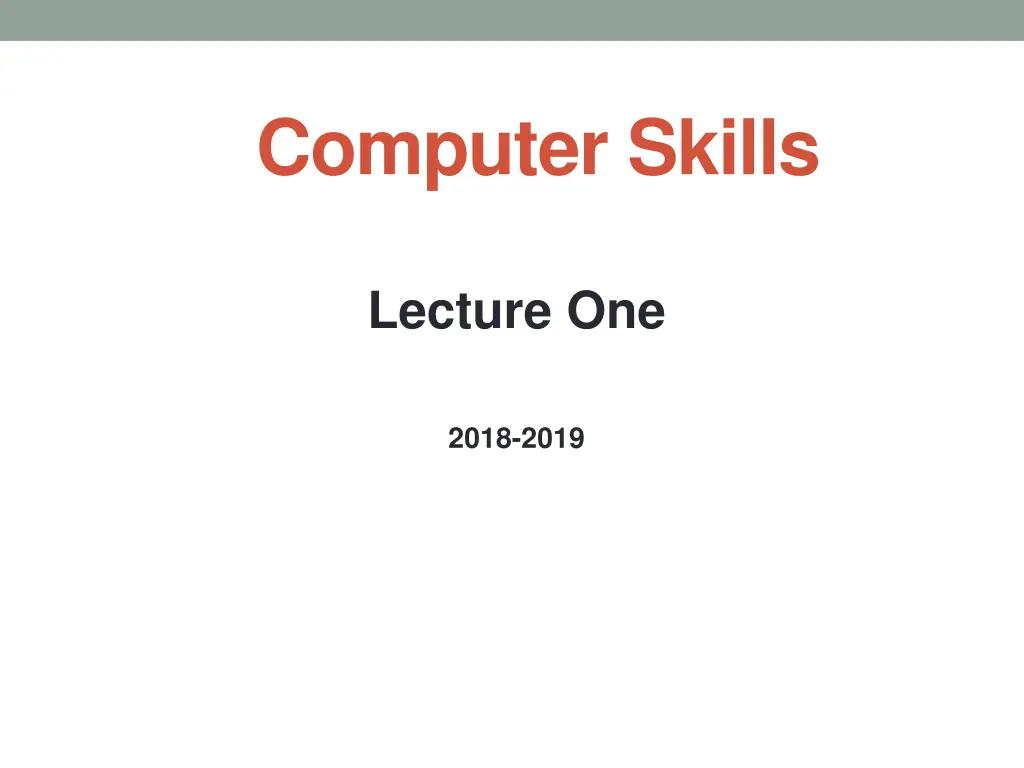
Evolution of Computers: Generations & Fundamental Concepts
Explore the history of computers through different generations - from vacuum tubes to microprocessors. Understand computer fundamentals like input, processing, output, storage, and communications. Discover the transition from first-generation to fifth-generation computers, including the introduction of artificial intelligence and potential future developments.
Uploaded on | 0 Views
Download Presentation

Please find below an Image/Link to download the presentation.
The content on the website is provided AS IS for your information and personal use only. It may not be sold, licensed, or shared on other websites without obtaining consent from the author. If you encounter any issues during the download, it is possible that the publisher has removed the file from their server.
You are allowed to download the files provided on this website for personal or commercial use, subject to the condition that they are used lawfully. All files are the property of their respective owners.
The content on the website is provided AS IS for your information and personal use only. It may not be sold, licensed, or shared on other websites without obtaining consent from the author.
E N D
Presentation Transcript
Computer Skills Lecture One 2018-2019
index History of computer Generations of Modern Computers Computer Fundamental Basic operations Understanding Information Systems Data vs. Information Computer Types Personal Computers Multi-User Computers
History of computer The history of computers is often referred to in terms of generations, each new generation is characterized by a major technological development.
First-generation computers (1946-1957) Made to order operating instructions Different binary coded programs told it how to operate Difficult to program and limited versatility and speed Vacuum tubes Magnetic drum storage
Second-generation computers (1958-1963) Transistors Memory - magnetic core Assembly language Printers and memory Programming languages Careers Third-generation computers (1964-1970) Used integrated circuits (ICs) Keyboards and monitors introduced
Fourth-generation computers (1971-present) Use microprocessors IBM PC, Apple Macintosh Use keyboards, mice, monitors, and printers Use magnetic disks, flash memory, and optical disks for storage Computer networks, wireless technologies, Internet introduced Fifth-generation (now and the future) May be based on artificial intelligence (AI) Likely use voice input May be based on optical computers and utilize nanotechnolog Let As see this you tub
Computer Fundamental Computer: A programmable, electronic device that accepts data, performs operations on that data, and stores the data or results as needed Computers follow instructions, called programs, which determine the tasks the computer will perform Basic operations Input: Entering data into the computer Processing: Performing operations on the data Output: Presenting the results Storage: Saving data, programs, or output for future use Communications: Sending or receiving data
Understanding Information Systems An information system is a complete interconnected environment in which raw data quantifiable facts and figures is turned into useful information. An information system includes the following parts: people Hardware Software Procedures data.
People: The first step in planning an information system is to analyze the requirements of the people. Hardware: physical parts of the computer system. The hardware includes circuit boards with silicon chips and transistors mounted on them, input devices like keyboard and mouse, and output devices like printers and monitors. Software: Computer hardware just sits there idle unless it has software, which is a program that tells the hardware what to do. Procedures: The software doesn t run itself (usually). People must interact with the computer to tell it what software to run. Data: Computer programs operate upon the data they receive.
Data vs. Information Data Raw, unorganized facts Can be in the form of text, graphics, audio, or video Information Data that has been processed into a meaningful form Information processing Converting data into information
Computers Types hardware is the physical part of the computer system. Hardware consists of components inside a computer as well as the external devices that interact with it, such as printers, cables, and monitors. Personal Computers Multi-User Computers
Personal Computers Desktop PC: A computer designed to be used at a desk, and seldom moved. This type of computer consists of a large metal box called a system unit that contains most of the essential components, with a separate monitor, keyboard, and mouse that all plug into the system unit
Notebook PC: A portable computer designed to fold up like a notebook for carrying The cover opens up to reveal a built-in screen, keyboard, and pointing device, which substitutes for a mouse. This type of computer is sometimes called a laptop.
Tablet PC: A portable computer that consists of a touch- sensitive display screen mounted on a tablet-size plastic frame with a small computer inside, There is no built-in keyboard or pointing device; a software-based keyboard pops up onscreen when needed, and your finger sliding on the screen serves as a pointing device.
Smartphone: A mobile phone that can run computer applications and has Internet access capability Smartphones usually have a touch-sensitive screen, provide voice calls, text messaging, and Internet access. Many have a variety of location- aware applications, such as a global positioning system (GPS) and mapping program and a local business guide.
Multi-User Computers Multi-user computers are designed to serve groups of people, from a small office to a huge international enterprise Server: A computer dedicated to serving and supporting a network, a group of network users, and/or their information needs. Many networks employ servers to provide a centrally accessible storage space for data, and share common devices like printers and scanners. A small network server may look similar to a desktop PC, but may have a different operating system, such as Windows Server or Linux.
Mainframe: A large and powerful computer capable of processing and storing large amounts of business data. For example, a mainframe might collect all the sales data from hundreds of cash registers in a large department store and make it available to executives.
Supercomputer: A supercomputer is the largest and most powerful type of computer available, occupying large rooms and even entire floors of a building.






















